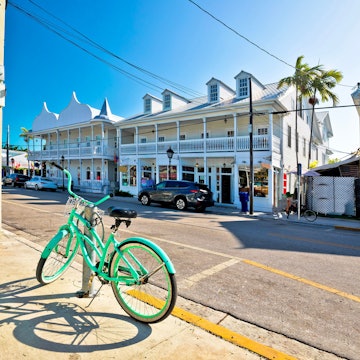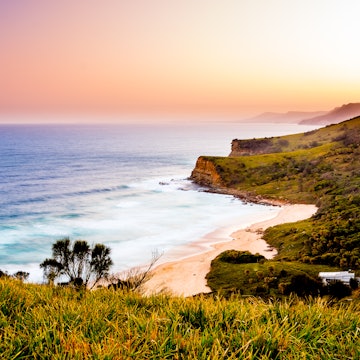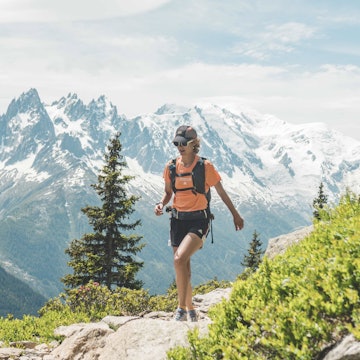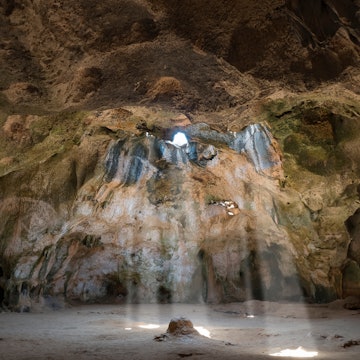

The sea cliffs of Española are just one of many awe-inspiring stops on a trip through the Galápagos © Sebastian Modak / Lonely Planet
Nature can be the best classroom and the Galápagos archipelago has much to teach us.
In a land of ancient tortoises and equatorial penguins, I fell for the humble mockingbird. About nine inches tall and with plumage that spans a dull spectrum of grays and browns, the Galápagos mockingbird seems like the kind of mundane specimen that blends seamlessly into the background. But after repeated encounters while traveling across the volcanic archipelago, I started noticing – and becoming enamored by – the animal’s behaviors and quirks.
There were its angry hazel eyes, set permanently in the expression of someone whose parking spot had just been stolen. The birds showed no fear of lumbering humans as they skittered across sand as white as snow, or pecked at my backpack’s zippers with the persistence of an overeager customs agent. Looking more closely, the differentiating characteristics of the various subspecies emerged. On the island of San Cristóbal, the eponymous mockingbird variety showed an especially brash disregard for personal space, a result of just how few humans visit its shores. Elsewhere, the Española mockingbird has developed a longer beak, perfect for burrowing into albatross eggs for a snack.

Focus long enough on any specific part of what makes this island chain so magical, I quickly realized, and more magic emerges. The islands are famous for being a living laboratory of evolution – a place where the minute changes brought on by natural selection can be witnessed from generation to generation, rather than era to era. But the Galápagos archipelago, as I discovered on a weeklong expedition cruise, has just as much to teach us about how to protect the natural world as it does how to understand and relish what’s left.
Lesson #1: Follow the rules

For most people, the Galápagos, a collection of 19 islands (and hundreds of islets) around 620 miles off the Pacific coast of mainland Ecuador, aren’t exactly a long weekend’s trip away. Like the Himalayan trek or an Antarctic cruise, this is a trip people save up for. Most travelers arrive by plane from the Ecuadorian cities of Quito or Guayaquil, after which they either settle into one of the hotels on the most populated island, Santa Cruz, or they board one of the many yachts and cruise ships that can be seen from the shoreline in the town of Puerto Ayora.
I booked my trip to the Galápagos with INCA, a luxury adventure tourism agency. It was the size of the group that most attracted me to the trip. Integrity, a gorgeously appointed yacht with spacious sun decks and an enthusiastically attentive Ecuadorian crew, only accommodates a maximum of 16 guests. When I was the first one off the panga – the inflatable dinghy that shuttled us between the yacht and daily shore landings – it could feel, even just for a second, like my feet were the first to ever touch this stretch of sand. Small-group tourism, while carrying a price tag prohibitive to many, encourages the kind of transformative experiences that are harder to find when you find yourself one of a throng. In the Galápagos, it’s a style of tourism that encourages conservation too, and most days, when we did share an anchorage with another ship, it was one not much bigger than ours.

This isn’t a coincidence. Ships with capacities larger than 100 guests are not allowed to operate in the Galápagos. Additionally, for every group of 16 visitors to the Galápagos National Park – an area that covers 97% of the land in the archipelago – there must be one licensed naturalist guide. Adventure in the Galápagos is, by necessity, controlled. Even if you wanted to go off-the-grid, bushwhacking your way across one of the islands, you couldn’t. This reveals a contradiction at the heart of traveling in the Galápagos: you are there to experience one of the last wild places on Earth, but to do so, you need to stick to the trails, follow the directions of your guide, and be back on the boat before sunset.
How did the Galápagos do what so many other places failed to do, building a system that at once protects the environment while allowing visitors to immerse themselves in it? For one thing, the islands had a head start. The government of Ecuador realized as early as the 1930s that what they had was special and introduced the first regulations around visitation numbers, species collection (an unfortunate global pastime 100 years ago), and fishing. In 1959, the Ecuadorian government officially established the Galápagos National Park. While so many corners of the world have fallen to pressure from other interests – oil companies in Alaska, for example, or logging conglomerates in the Brazilian rainforest – the Galápagos has only expanded the scope of its protected status in the years since.

Last year, Ecuador announced an expansion of the already massive Galápagos Marine Reserve, an oceanic counterpart to the national park. As Reuters reported, an expansion of some 60,000 square kilometers was the first step towards a planned network of marine wildlife corridors that will not only protect the animals that make the Galápagos their home year-round, but also migratory species who pass through these cold Pacific waters.
Patricia Stucki is a Swiss-born naturalist guide who has lived and worked in the Galápagos for 27 years, where she also has a small cocoa farm. Over the course of our trip, I had many opportunities to hear what it was like to watch an isolated corner of the world become a destination that attracts some 250,000 visitors a year. While I’m used to a certain level of skepticism towards tourism from people lucky enough to have settled down in the world’s most beautiful places, I found mostly cautious optimism in my conversations with Stucki. I had the distinct impression that the Galápagos will always place nature and the community first, and tourism third.

For example, Stucki told me how strange it was to read all the accounts of how nature had made a global comeback during the Covid-19 pandemic; the dolphins seen in the canals of Venice and the whales spotted in New York City. “Here, not a lot was different when I returned to the outlying islands – it wasn’t like there was suddenly all this new wildlife,” Stucki said. “It felt like always. I think that shows how good of a job we’ve done at protecting it and how wild it really is.”
Lesson #2: Go with the flow
Most liveaboard travelers, myself included, choose between two itineraries. On the western route, trips focus on the geologically younger islands of Fernandina and Isabela. The eastern route, on the other hand, passes through what’s left of the first land formations to appear here more than 4 million years ago, pushed up from the earth’s mantle. The geology and ecology of the Galápagos are so incredibly diverse from island to island that it can feel like you are playing a constant game of FOMO when selecting an itinerary. Choose the western route, and you’ll see the flightless cormorant, an icon of the islands’ penchant for bizarre spins on familiar species. But choose the eastern one, and you might see waved albatrosses engaged in elaborate courtship rituals, clacking their beaks and rocking their heads back and forth as if to some secret rhythm. What to do?

I ended up opting for the eastern route, more due to timing than anything else. After a brief visit to El Chato Reserve, a farm where free-roaming Galápagos tortoises amble, chew and stare with little concern for all the tourists who visit, I boarded Integrity in the commercial hub of Puerto Ayora, and we were off.
The evolution of species and the randomness of volcanic geology has played out in a way that makes every island feel like its own world. Nazca and Blue-footed boobies dive bomb into the sea in a bright turquoise bay on Española; their red-footed counterparts stare from behind thick tangles of mangroves on the avian paradise of Genovesa. On San Cristóbal, famously Charles Darwin’s first stop on his five-week journey in the Galápagos, giant relatives of the daisy grow impossibly out of sand-colored cliffs that wouldn’t be out of place in the Sahara; on Santa Fé, what from a distance look like pine trees are actually prickly pear cacti, growing from thick red trunks.
In between landings and activities, I spent hours on deck under the afternoon sun, watching frigatebirds float like kites above our ship. At night, I’d return and see ghosts shimmering in the moonlight: swallow-tailed gulls, the world’s only nocturnal gull.

In the lead-up to my trip, every Galápagos expert I spoke to responded to my crisis of choice – east or west – with some version of “choose either.” I quickly saw why. The Galápagos are wondrous in so many ways; there’s no way to contain the beauty of all the islands in a single trip, so you’re best off not even trying to. Every “must-see” list is as much a limitation as it is an invitation; sometimes, it’s better to just go.
“If somebody comes back a second time and does even the exact same tour, do not expect to see what you saw the first time,” Stucki said. “Just come with a blank slate and enjoy whatever the week throws at you.”
Lesson #3: Pay attention
These days, the Galápagos attracts a wide range of travelers – from charter yachters looking to shovel caviar in their mouths while turning a worrisome shade of pink under the equatorial sun – to hardcore scuba divers exploring the alien world under the Pacific. But the Galápagos archipelago is perhaps most known for being the intellectual spark plug for what would become Charles Darwin’s Theory of Evolution. It only takes a few days to understand what might have been going through Darwin’s head nearly 100 years ago. This is a place that encourages you to think, to learn, and to expand your comprehension of what’s possible on this planet we are so lucky to inhabit.
On my first day in the Galápagos, as I toured the island of Santa Cruz before boarding Integrity, I overheard a conversation taking place among my fellow travelers. One guest, a woman in her sixties or seventies, was worrying out loud about the daily snorkeling that was part of the itinerary – she had never done it before. Maybe, she reasoned, she’d be better off staying on the boat during those outings. Federico Zambrano, a young national park guide who grew up on the islands, interjected, the pain visible in his voice.

“You must get in the water,” Zambrano pleaded. “At least half the magic of the Galápagos is underwater.”
Our snorkeling sessions quickly became what I most looked forward to, in large part because of the education they provided. These are not the tropical coral reefs I expected based on previous snorkeling and scuba trips – but there was just as much life. After each snorkeling excursion, I’d rush back into the yacht’s library, flipping through fish identification guides and mentally checking off what I had seen. A hieroglyphic hawkfish, named for the psychedelic patterns that cover its scales: check. Yellowtail surgeonfish by the hundreds, appearing out of the deep blue like a blanket of shimmering silver and gold: at every site. Neon-colored anemones clinging to the rocks, waving their tentacles to the rhythm of the currents: yup.
At one site, my heart stopped beating for a split second as I saw the unmistakable silhouettes of hammerhead sharks drifting right ahead of me. At another, Galápagos penguins, just another of the many species that seemed to have taken a wrong turn at Patagonia, swam inches from my mask with the ease of birds in flight.

On the last snorkel excursion of the trip, somewhere off the southern coast of the island of Santiago, a sea lion approached our group, curious and looking to pass some time. It did somersaults, blowing bubbles up into our faces. It challenged me to a game of chicken, rushing straight towards me before snapping its jaws and veering away just in time. It hung around for almost 10 minutes, darting back and forth, before growing bored and swimming away.
For those moments, it felt not like we were visitors to this environment but that we, too, in our own way, belonged here. That we could stay, as long as we didn’t overstep the boundaries that nature had already set. When I broke the surface, I felt a sense of joy and peace that can so often escape me in the day-to-day. Turning to see if I could catch a last glimpse of the sea lion porpoising down the coastline, I saw that my hesitant traveling companion was there too, mask still equipped, a wide smile on her face.
Lesson #4: Lean into learning

The Galápagos Islands and the seas that surround them seem impossible, more like magic than science, until you learn that everything has an explanation. After days of islands dominated by beaches and rocks, Santiago feels like another planet – a seemingly never-ending sea of black lava flow, frozen in time into fissures and waves. What started as pure wonder quickly turned into a lesson on volcanology: how the shape of the volcano allowed the lava to spread over such a large area, a kind of slow-motion answer to the evidence of the more violent eruptions that can be found elsewhere in the archipelago.
Every little detail in the Galápagos is there for a reason, one that over time has carved out its place in the order of things until some other more advantageous trait nudges it aside. As I experienced them, asked questions, and pored over the books in the yacht’s library, a new understanding emerged. The dive-bombing boobies are able to slam into the water with such ferocity because of specialized features in their skulls that protect their squishy brains. The beaks of the various interrelated finches – the subject of Jonathan Weiner’s Pulitzer-winning book about how evolution can play out on a micro-scale – together form a kind of toolbox, each with adaptations that make it perfect for each need.

There was a childlike excitement to my mornings aboard Integrity. It reminded me of the joy that comes from learning not because you have to, but because your curiosity has been broken open like a seed crushed by a ground finch’s hammer-like beak. Galápagos’s tourism model is one based on conservation and education, but it’s also one instilled with a virtuous mechanism of self-reinforcement. Seeing the raw, untouched natural world up close makes you want to learn about it and protect it – the more you do both those things, the more of it you want to see.
Lesson #5: Don’t look away; there’s still so much to do

It is easy to leave the Galápagos feeling entirely optimistic, a rare outcome in a world of warming global temperatures, rising sea levels and frequent extinctions. Any traveler is selfishly always on the lookout for justification that by traveling, they are doing good. In the Galápagos, where 85% of the economy is dependent on tourism and where that industry has been placed under more controls than most places on earth, it’s a natural feeling to ease into. But – there’s always a but – the Galápagos has just as much to teach us about the threats that still exist to our natural world as the successes of conservation.
Most people I spoke to did not seem worried that the authorities in charge of the national park would start slipping on their restrictions anytime soon, tempted perhaps to raise the ship capacity limits or reduce the area protected from 97% to something lower. Tourists pay a lot of money to be somewhere pristine – low-volume tourism (relatively speaking) appears to be the future of tourism for the time being. But not everyone has the means to book a week on a luxury yacht. Land-based tourism, where people post up at hostels or hotels, taking day trips or looking for a beach-style vacation, is on the rise. Officials are prioritizing figuring out ways to make those just as sustainable and controlled as liveaboards, but the way forward seems uncertain.
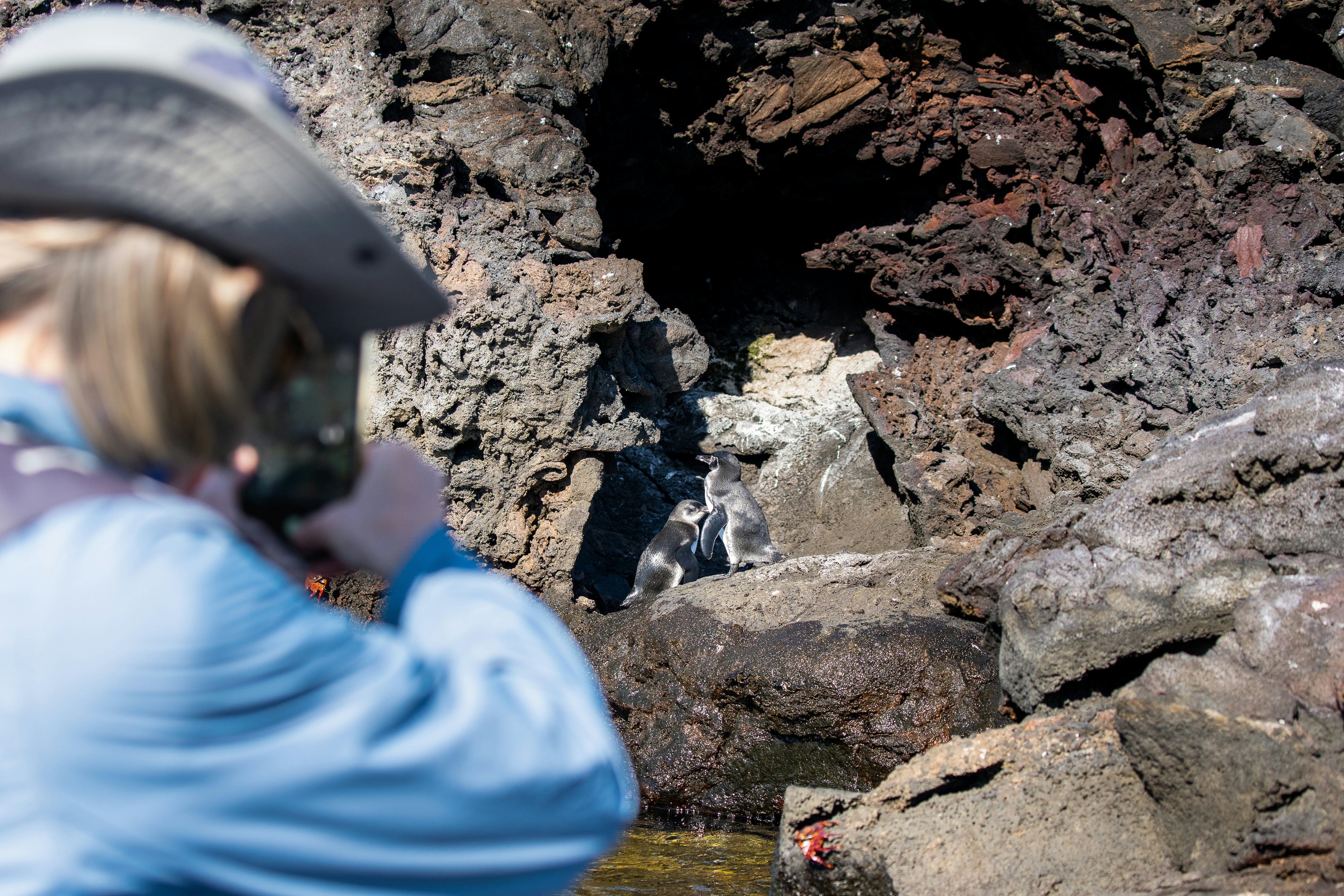
Ivonne Torres is originally from Guayaquil on the Ecuadorian mainland but has lived in the Galápagos since 1987. While she spent many years as a naturalist guide, she now works for the Galápagos Conservancy, an American nonprofit committed to conservation education, rewilding and species protection. She says that tourism in the Galápagos these days is split about 50-50 between land-based tourism and liveaboards. The mechanisms to protect the areas that fall outside the national park – the ones that house local communities and attract tourists from all over the world, including many from the mainland – are still evolving.
“The national park sets rules that the liveaboards must follow, but it obviously doesn’t have any management on that 3% of the islands that are not part of the park, and that’s where more hotels are trying to move in,” Torres said. “What we can do as a community – and what we have done – is come together to block new permits for new large hotels that would really take money out of the Galápagos.”

Other threats and uncertainties remain too. Biosecurity is taken seriously in the Galápagos as a single invasive species can shatter an ecosystem this fragile and interconnected. Ever since humans have lived on these islands, the introduction of a variety of species – from goats to snails – have, at one point or another, overrun sections of the island and disrupted food chains. Each time, Galápageños and their international partners and supporters have found a way forward, relocating, containing or exterminating invaders to restore some version of equilibrium, but a single errant insect can still pose an existential threat.
And then there’s our insatiable hunger for all the bounty of the sea. The stretches of the Pacific just outside the boundaries of the Galápagos Marine Reserve attract fishing ships from around the world. A 2020 investigation by Oceana, an ocean conservation group, found that one flotilla of Chinese fishing vessels right outside the boundaries of the protected zone was responsible for a staggering 73,000 hours of industrial-level fishing in just one month. People all over the world were quick to express anger, not always aware of their own contributions to the global demand for cheap seafood.

The Galápagos Islands can feel so strange, so apart from other parts of the world that it can be hard to remember its existence depends on the same interwoven web of commerce and politics as everywhere else. It can be tempting to try and disengage, but visiting the Galápagos is a crucial reminder of the immense human effort involved in leaving our wild places alone.








